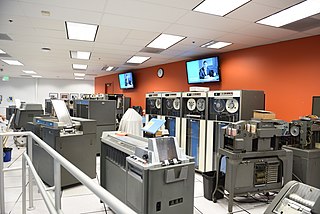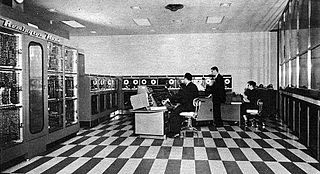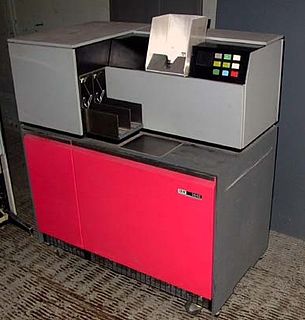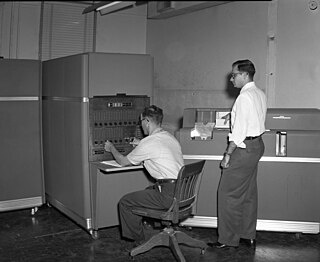
A punched card is a piece of stiff paper that holds digital data represented by the presence or absence of holes in predefined positions. Punched cards were once common in data processing applications or to directly control automated machinery.

A line printer prints one entire line of text before advancing to another line. Most early line printers were impact printers.

The IBM 1620 was announced by IBM on October 21, 1959, and marketed as an inexpensive "scientific computer". After a total production of about two thousand machines, it was withdrawn on November 19, 1970. Modified versions of the 1620 were used as the CPU of the IBM 1710 and IBM 1720 Industrial Process Control Systems.

The IBM 1401 is a variable-wordlength decimal computer that was announced by IBM on October 5, 1959. The first member of the highly successful IBM 1400 series, it was aimed at replacing unit record equipment for processing data stored on punched cards and at providing peripheral services for larger computers. The 1401 is considered to be the Model-T Ford of the computer industry, because it was mass-produced and because of its sales volume. Over 12,000 units were produced and many were leased or resold after they were replaced with newer technology. The 1401 was withdrawn on February 8, 1971.

UNIVAC was a line of electronic digital stored-program computers starting with the products of the Eckert–Mauchly Computer Corporation. Later the name was applied to a division of the Remington Rand company and successor organizations.

An IBM card sorter is a machine for sorting decks of punched cards in the format popularized by the International Business Machines Corporation (IBM), which dominated the punched card data processing industry for much of the twentieth century. Sorting was a major activity in most facilities that processed data on punched cards using unit record equipment. The work flow of many processes required decks of cards to be put into some specific order as determined by the data punched in the cards. The same deck might be sorted differently for different processing steps. The IBM 80 series sorters sorted input cards into one of 13 pockets depending on the holes punched in a selected column and the sorter's settings.

IBM 1442 is a combination IBM card reader and card punch. It reads and punches 80-column IBM-format punched cards and is used on the IBM 1440, the IBM 1130, the IBM 1800 and System/360 and is an option on the IBM System/3.

Starting at the end of the nineteenth century, well before the advent of electronic computers, data processing was performed using electromechanical machines collectively referred to as unit record equipment, electric accounting machines (EAM) or tabulating machines. Unit record machines came to be as ubiquitous in industry and government in the first two-thirds of the twentieth century as computers became in the last third. They allowed large volume, sophisticated data-processing tasks to be accomplished before electronic computers were invented and while they were still in their infancy. This data processing was accomplished by processing punched cards through various unit record machines in a carefully choreographed progression. This progression, or flow, from machine to machine was often planned and documented with detailed flowcharts that used standardized symbols for documents and the various machine functions. All but the earliest machines had high-speed mechanical feeders to process cards at rates from around 100 to 2,000 per minute, sensing punched holes with mechanical, electrical, or, later, optical sensors. The operation of many machines was directed by the use of a removable plugboard, control panel, or connection box. Initially all machines were manual or electromechanical. The first use of an electronic component was in 1937 when a photocell was used in a Social Security bill-feed machine. Electronic components were used on other machines beginning in the late 1940s.

The IBM 1403 line printer was introduced as part of the IBM 1401 computer in 1959 and had an especially long life in the IBM product line. The original model could print 600 lines of text per minute and could skip blank lines at up to 75 inches per second (190 cm/s), while the model 3 could print at up to 1400 lines per minute. The standard model had 120 print positions. An additional 12 positions were available as an option. A print chain with up to 15 copies of the character set spun horizontally in front of the ribbon and paper. Hammers struck the paper from behind at exactly the right moment to print a character as it went by. In later models, the print chain was replaced by a print train; print slugs instead of being mounted on a chain were placed in a track.

A keypunch is a device for precisely punching holes into stiff paper cards at specific locations as determined by keys struck by a human operator. Other devices included here for that same function include the gang punch, the pantograph punch, and the stamp.

The IBM 407 Accounting Machine, introduced in 1949, was one of a long line of IBM tabulating machines dating back to the days of Herman Hollerith. It had a card reader and printer; a summary punch could be attached. Processing was directed by a control panel.

The IBM 557 Alphabetic Interpreter allowed holes in punched cards to be interpreted and the punched card characters printed on any row or column, selected by a control panel. Introduced in 1954, the machine was a synchronous system where brushes would glide over a hole in a punched card and contact a brass roller thereby setting up part of a character code.

The tabulating machine was an electromechanical machine designed to assist in summarizing information stored on punched cards. Invented by Herman Hollerith, the machine was developed to help process data for the 1890 U.S. Census. Later models were widely used for business applications such as accounting and inventory control. It spawned a class of machines, known as unit record equipment, and the data processing industry.

A plugboard or control panel is an array of jacks or sockets into which patch cords can be inserted to complete an electrical circuit. Control panels are sometimes used to direct the operation of unit record equipment, cipher machines, and early computers.
The IBM 101 Electronic Statistical Machine, introduced in 1952, combines in one unit the functions of sorting, counting, accumulating, balancing, editing, and printing of summaries of facts recorded in IBM cards.

A computer punched card reader or just computer card reader is a computer input device used to read computer programs in either source or executable form and data from punched cards. A computer card punch is a computer output device that punches holes in cards. Sometimes computer punch card readers were combined with computer card punches and, later, other devices to form multifunction machines. It is a input device and also an output device. Most early computers, such as the ENIAC, and the IBM NORC, provided for punched card input/output. Card readers and punches, either connected to computers or in off-line card to/from magnetic tape configurations, were ubiquitous through the mid-1970s.

The IBM 402 and IBM 403 Accounting Machines were tabulating machines introduced by International Business Machines in the late 1940s.

The IBM 533 Input-Output Unit, announced on July 2, 1953, was a punched card reader and punch that served as the primary input-output unit for the IBM 650 computer. It had two independent card paths, one for reading and one for punching. IBM cards were fed face down, 12-edge first. All 80 columns could be read and punched by the computer as numeric data, but alphanumeric reading was severely limited on the basic 650 and require special control panel wiring.

The IBM 421 accounting machine saw use in the 1960s.

















